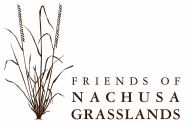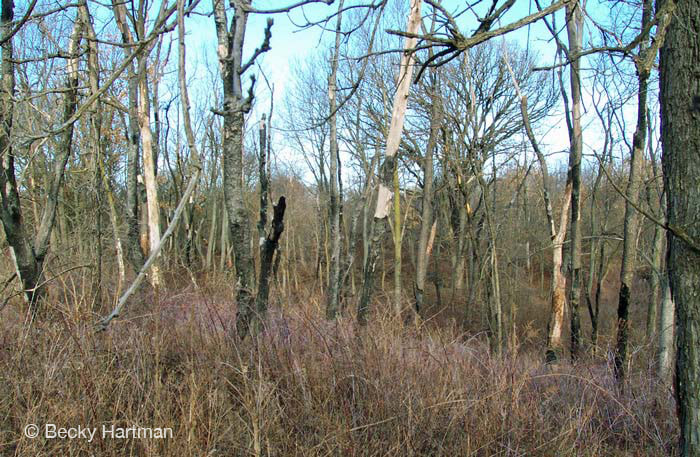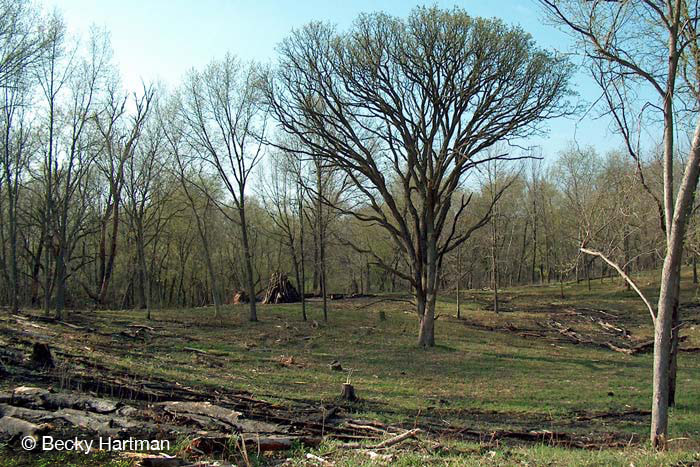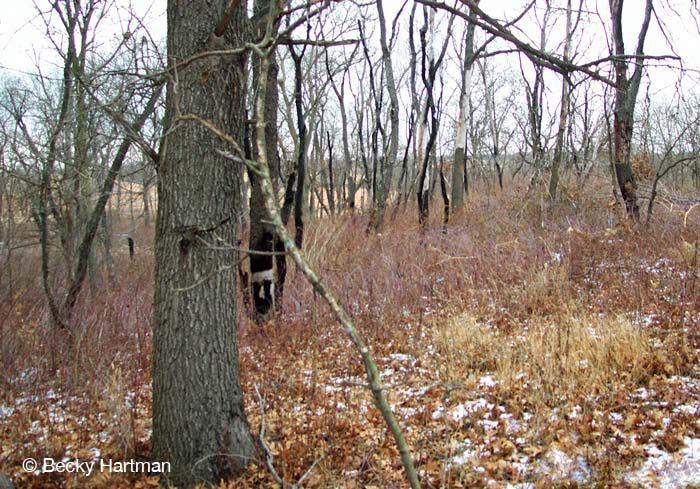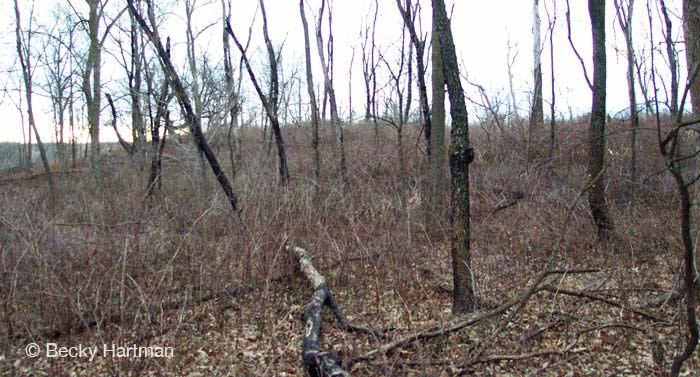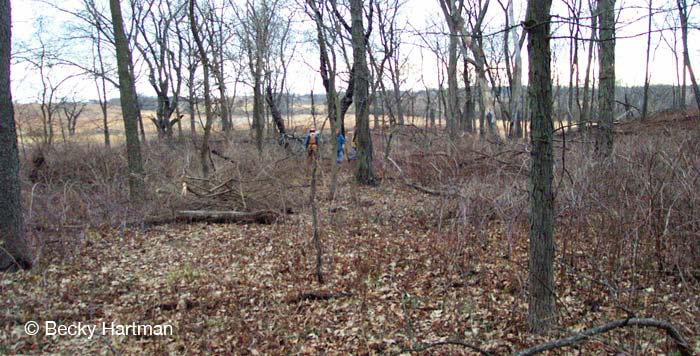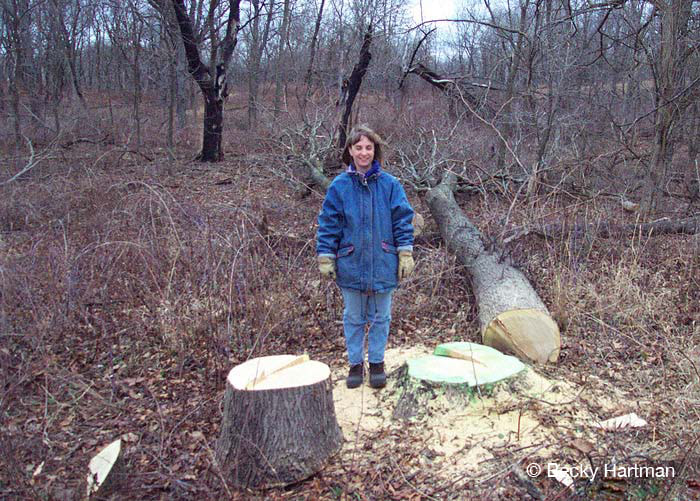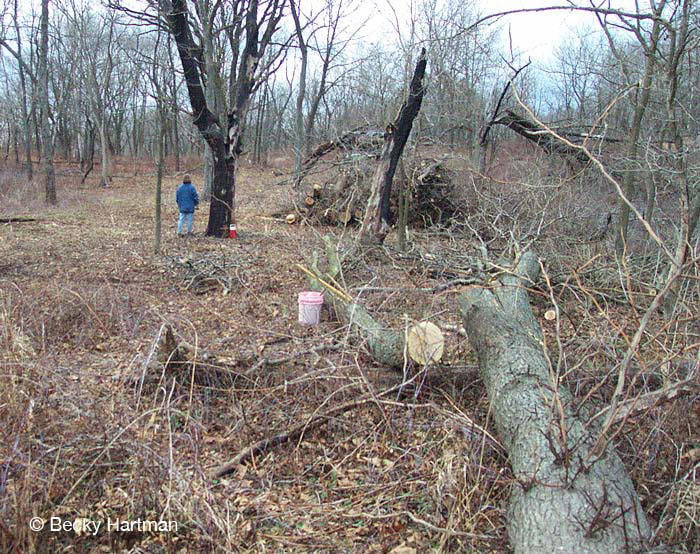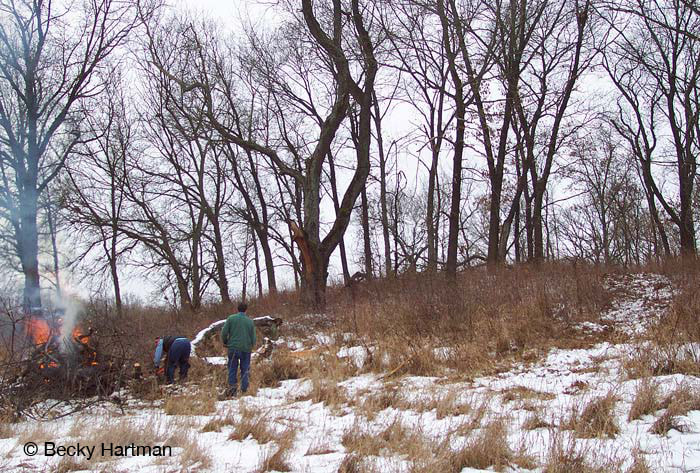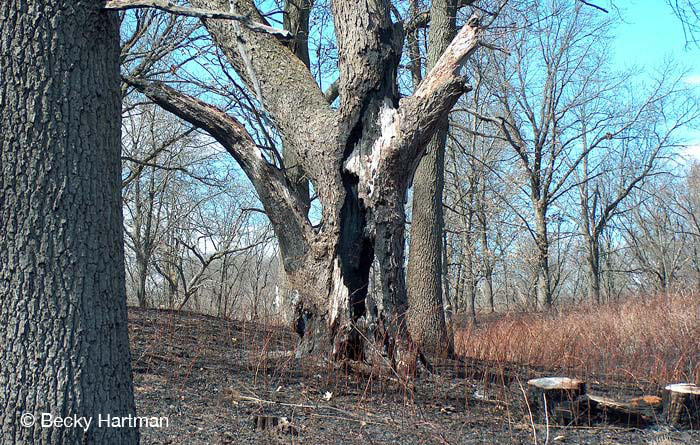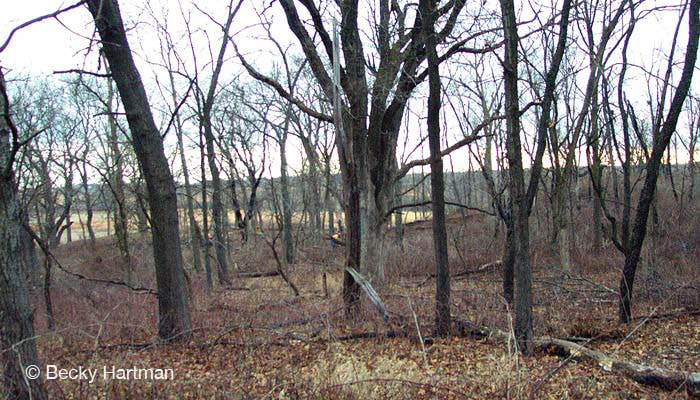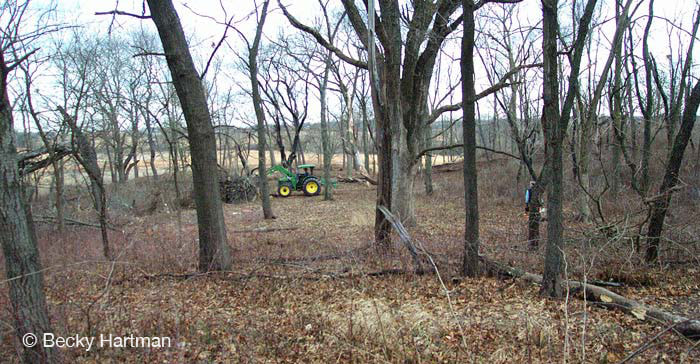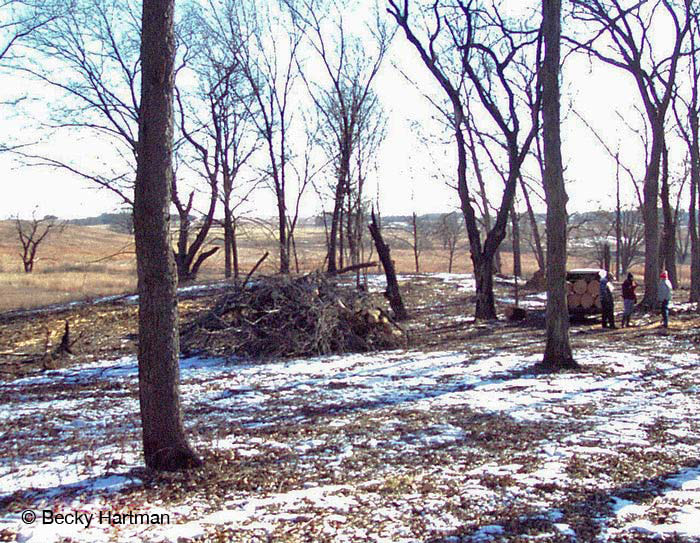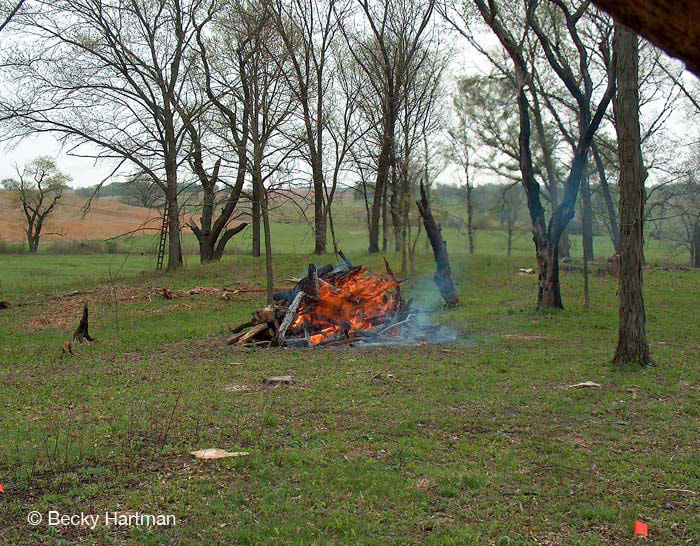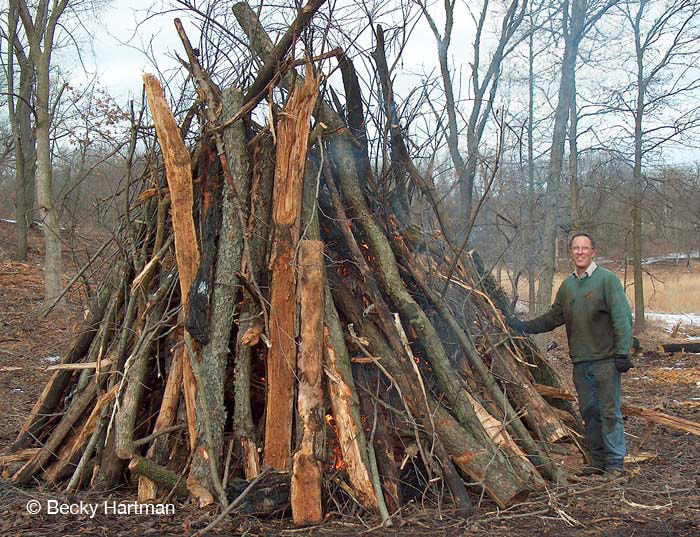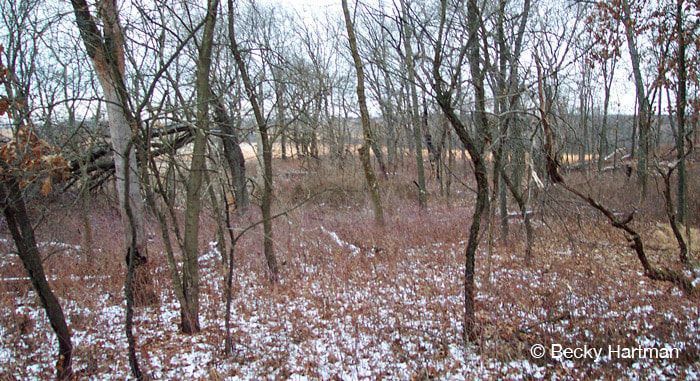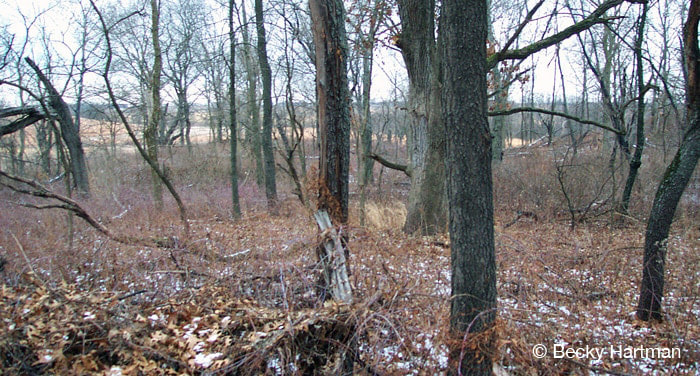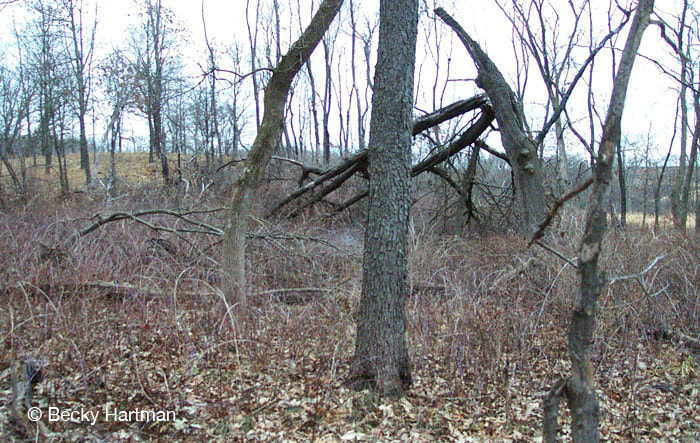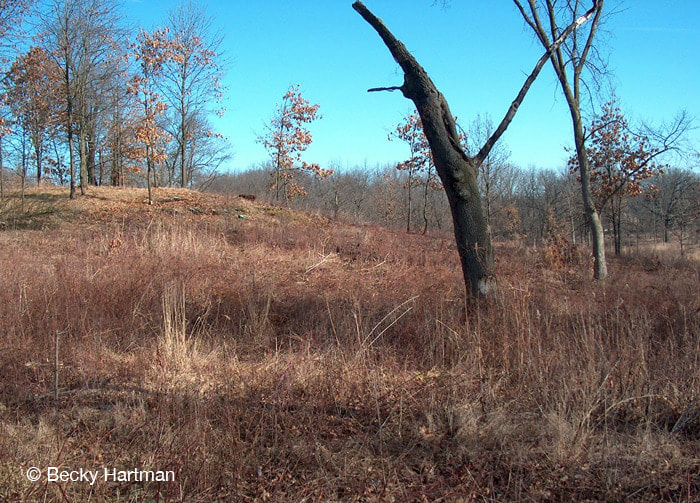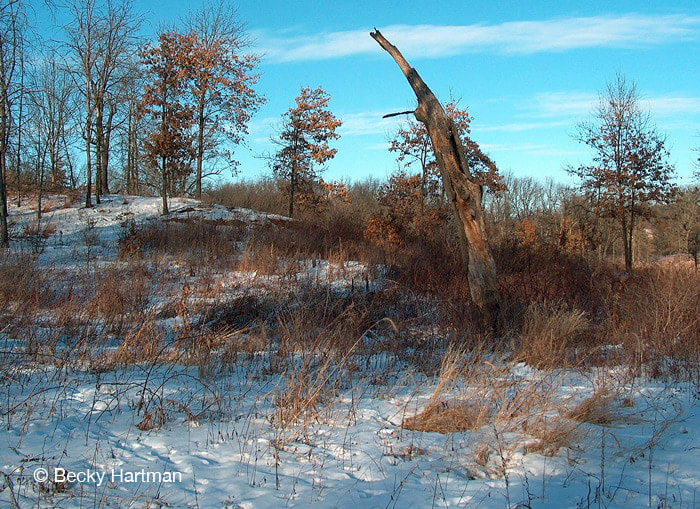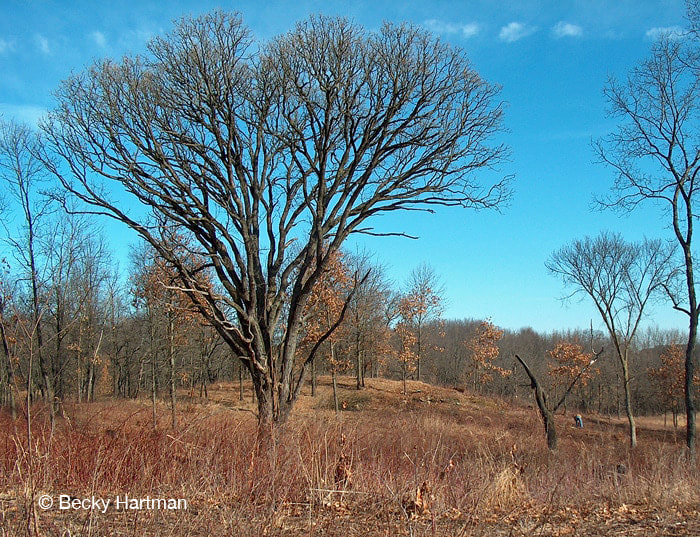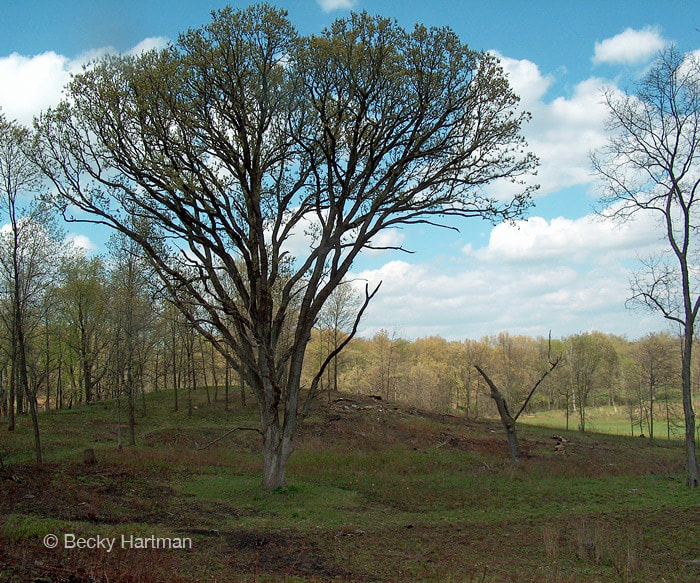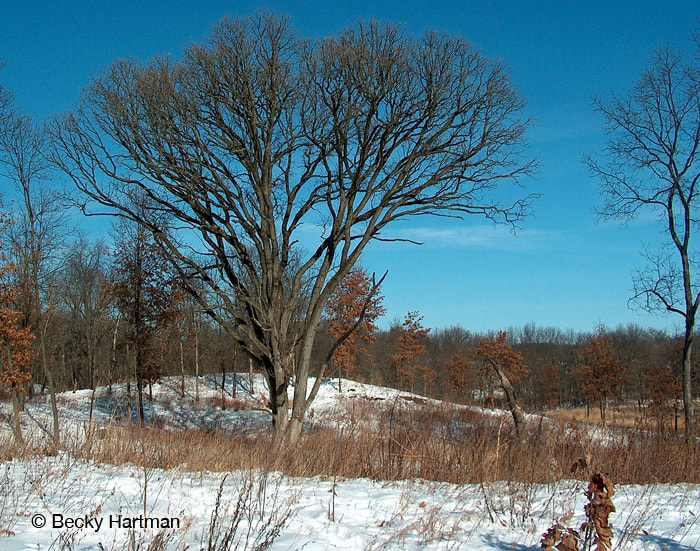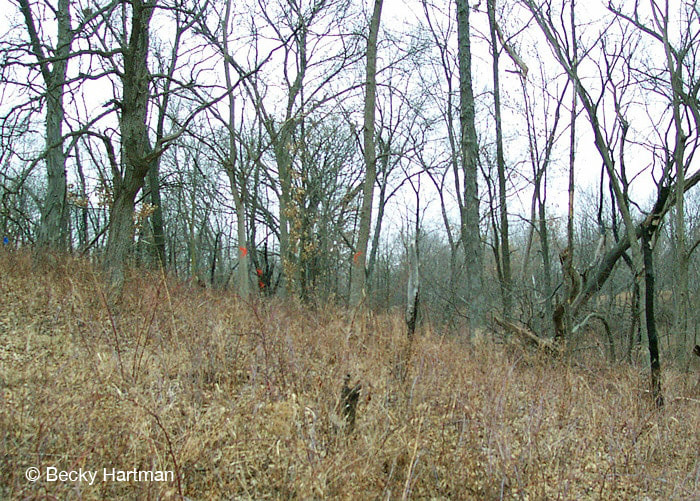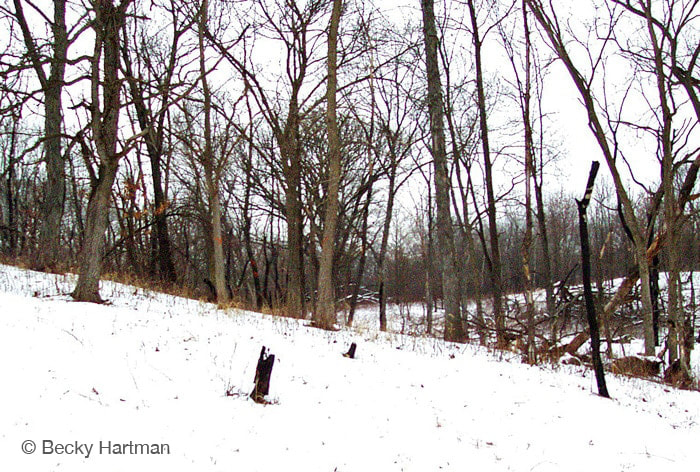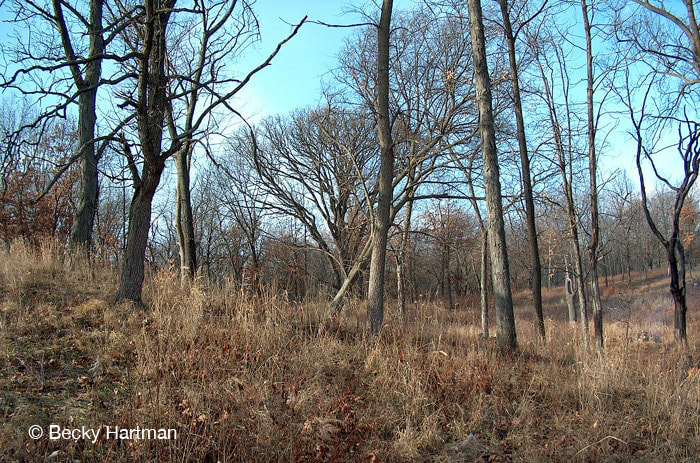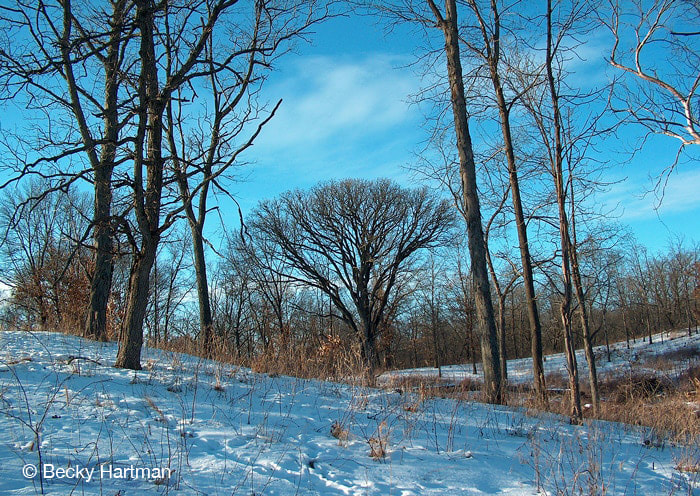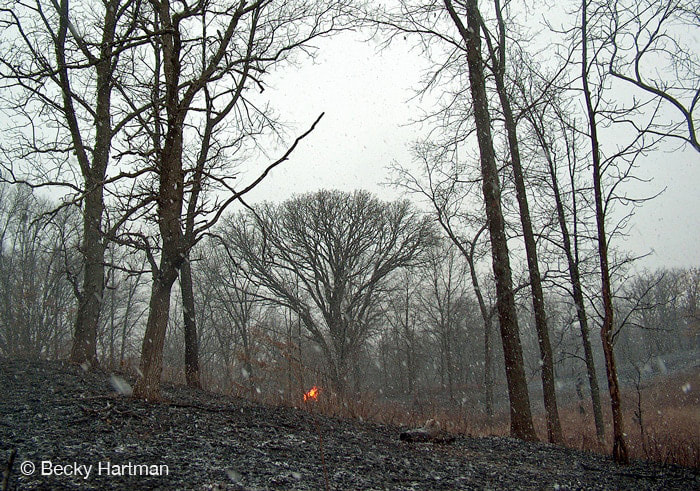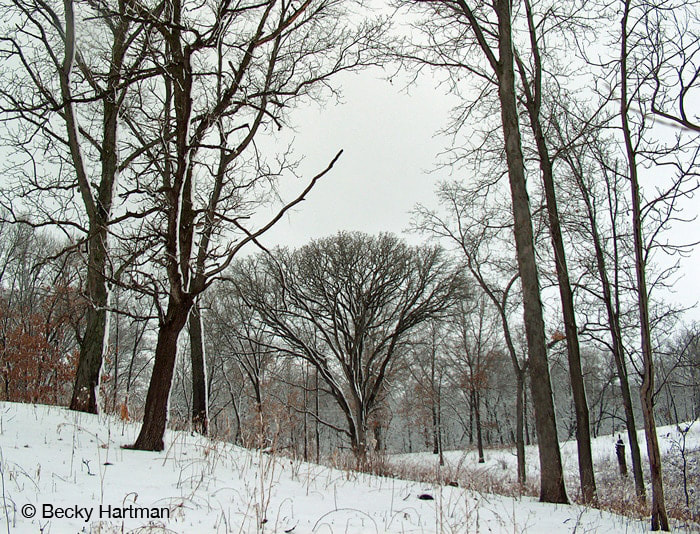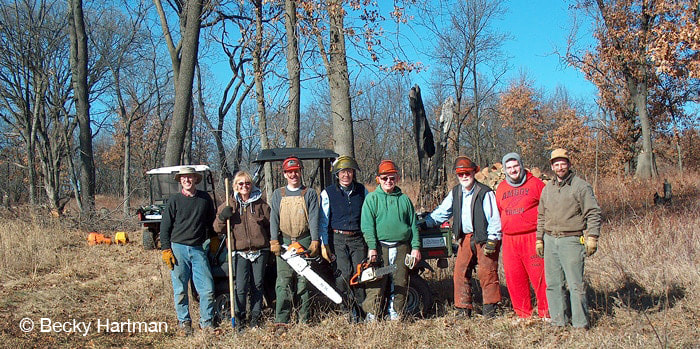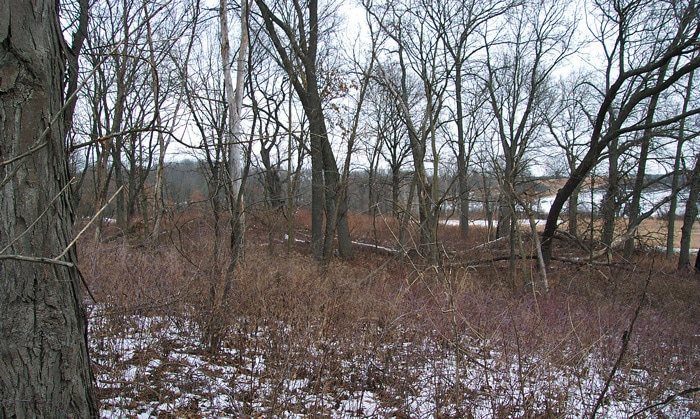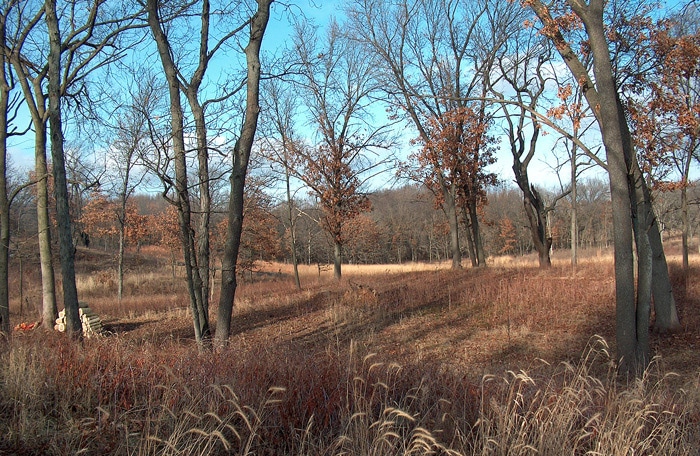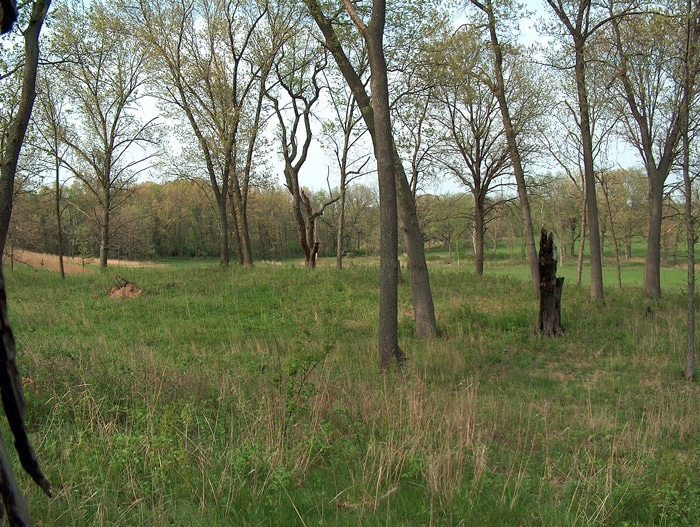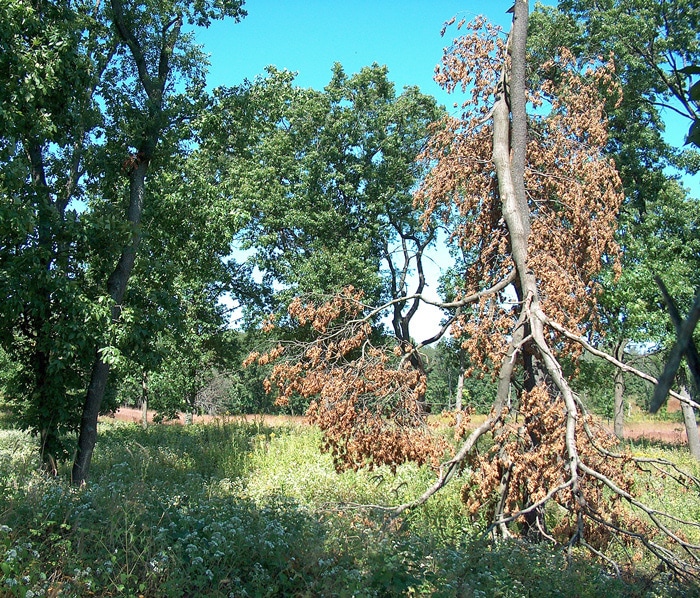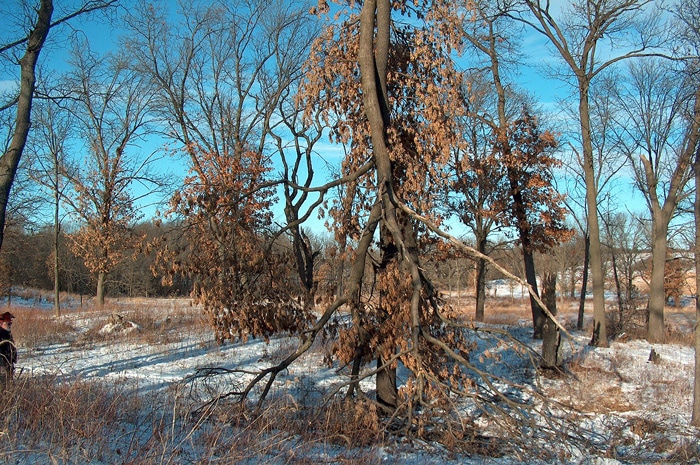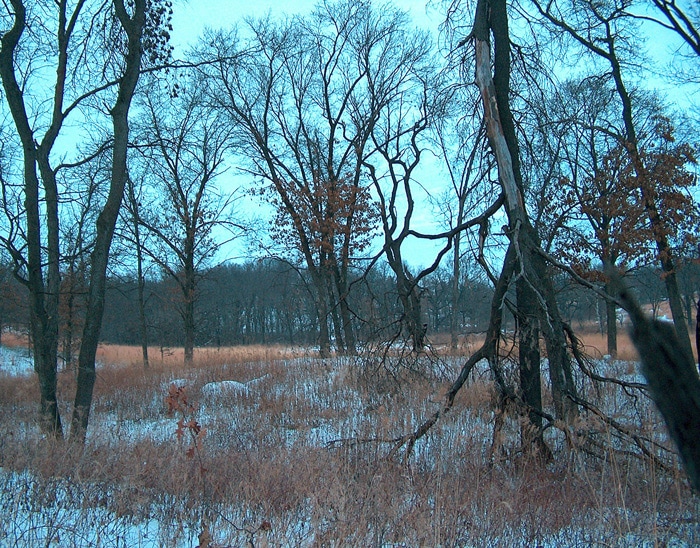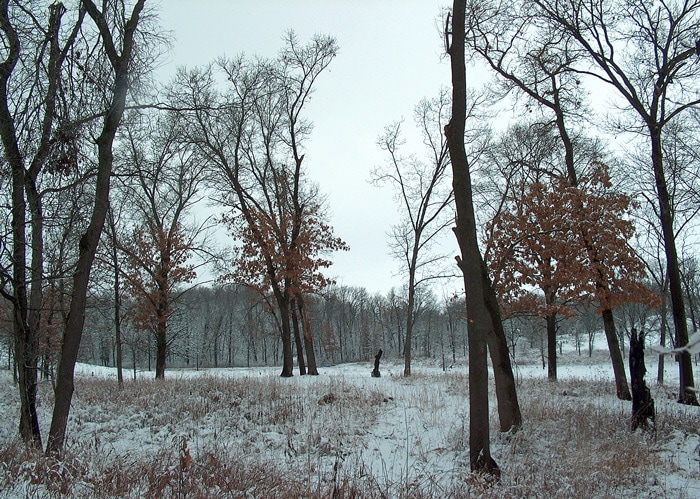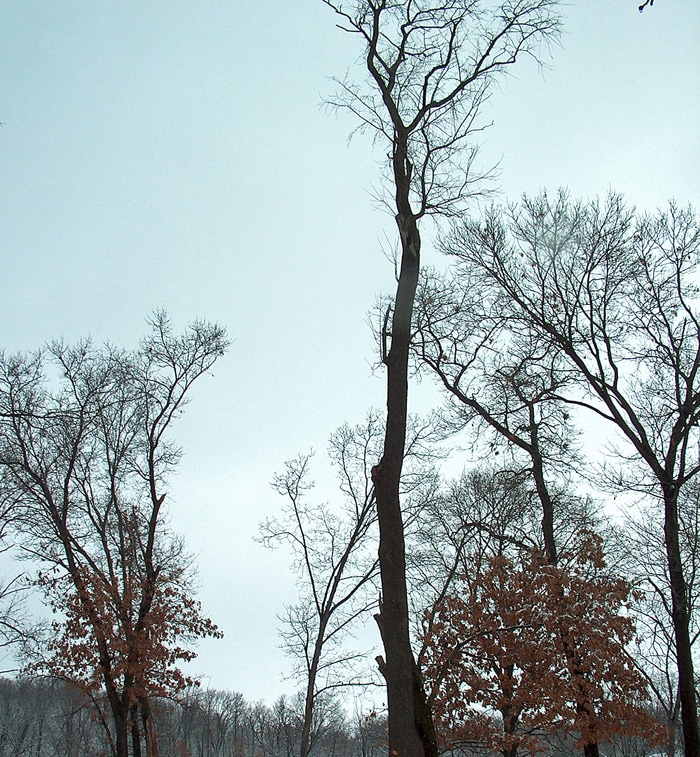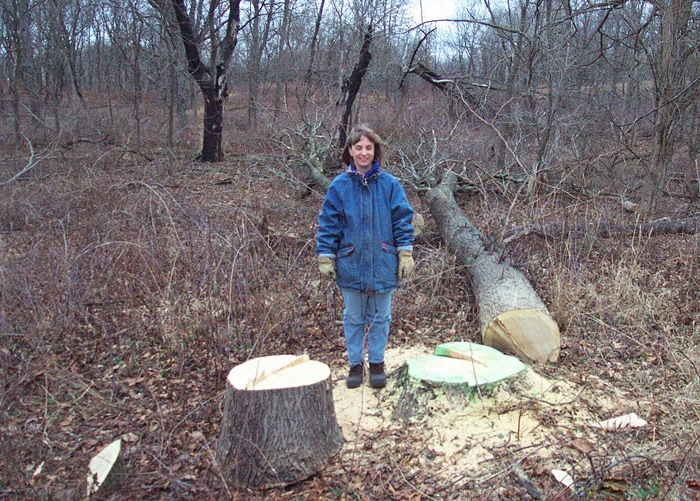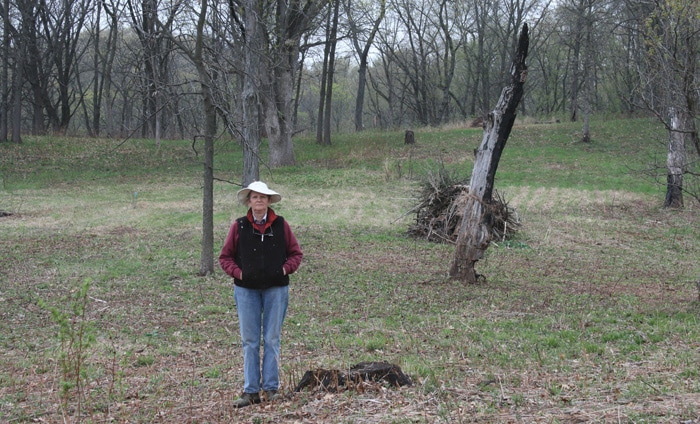Hickory Hollow and East Knob
There are three distinct “bumps” aka “knobs” in this photo. It is taken from Wade Bottoms looking to the west. On the left behind the foreground hickory tree is South Knob, which stretches to the west. The low rise in the center is East Knob and the taller rise on the right is Middle Knob. Beyond East Knob, the connection between South Knob and Middle Knob is a slight dip named the Saddle. The lower area beyond and to the sides of East Knob is Hickory Hollow since there are hickory trees there. The large bur oak (Hitchcock) is at the west end of Hickory Hollow.
Photo above was taken on the top of the east end of South Knob looking northwest across Hickory Hollow to Hitchcock. Hitchcock is a big bur oak which is visible from many locations. It’s quite impressive. Remember the 2002 photos every time you see Hitchcock in a later photo. This is what Hickory Hollow looked like before it was cleaned up.
The geoboy mower removed a large amount of brush from Big Woods in January 2004. Note burn pile #14.1 on the Saddle west of Hitchcock. Also observe the huge amount of trash on the ground to be cleared away. Photo was taken from the same spot as the previous photo.
Photo taken from west end of the top of South Knob looking east across north face of South Knob. East Knob is in left half of photo. The large trunk foreground oak is still flourishing in 2012. In 2001, beginning at this point there was only a faint game trail leading north across the eastern edge of the Saddle to Middle Knob.
At the very end of the year 2003 we worked for the first time in Hickory Hollow. We built the first Hickory Hollow burn pile #11.1 on December 27 but did not burn it until January 1, 2004. It included a lot of dead cherry and some storm–downed oak and other assorted trash. This photo is standing at Hitchcock looking southeast at Which Way tree. This is the north side of South Knob which has not responded well to seeding. It is also the southern boundary of Hickory Hollow. After the geoboy knocked down the dead snags in 2004, Al Meier single handedly stacked most of it onto the Hickory Hollow burn pile. (See Al in the photo near the end of this section.)
Standing at Hitchcock looking east at East Knob. East Knob is the rise in the center background. At the north edge of East Knob is a gnarly cherry tree which we will reference as North Cherry. South Knob is at the right but not visible. Chris and Jennifer Hauser are standing where burn pile #11.1 will be.
A big start to the workday. Looking west in Hickory Hollow from the top of East Knob. Theoretically you should be able to see Hitchcock in both the next two photos of Jennifer Hauser. Chris Hauser took this tree down. Thanks Chris.
Jennifer & Chris Hauser & Jan Grainger all participated in the fun. Lots of change by the end of the day. The snag in front of burn pile #11.1 is not the same snag as shown later in this section. The later snag is further west beyond burn pile #11.
This photo of North Cherry is taken from the field north of East Knob. Hank and Al Meier are working on burn pile #8.1. You can see where one branch broke off from some storm; that produced a limb stub which is very distinctive in other photos. This cherry was visible in most photos of East Knob until 2012. It is named only for the purpose of referencing it in this section.
This is what North Cherry looked like after prescribed fire in April 2011. It looked much too unstable to attempt chainsawing it. The prescribed fire in December 2011 did cause it to fall over.
Standing on the Saddle trail in the morning of the first Hickory Hollow workday looking east. Hitchcock is being smothered by surrounding junk. Dead lower limbs indicate it was an open grown oak. North Cherry is visible in the distance on East Knob at the left edge of the next four photos.
The area is beginning to look a little bit more open by the end of the day.
We have walked east from the previous photo to stand by the trunk of Hitchcock. Burn pile #11.3 is in Hickory Hollow looking east at East Knob. Burn piles #11.1 and #11.2 were built and burned prior to the Geoboy mowing.
Burn pile #11.6 in Hickory Hollow. Upper right hand corner is limb of Hitchcock. Photo is looking east across East Knob with Wade Bottoms in the background. Note all the stumps in this picture which were trees in earlier photos. The orange flag marks Podophyllum peltatum.
Al Meier, proud of creating Burn pile #11.5 in Hickory Hollow. Al built several more of these. The next time we burn brush here in 2012 it will be #11.22.
The next two photos are before shots to set up looking at Hickory Hollow from the top of South Knob.
This photo is taken from the game trail running north–south across the east edge of the Saddle. Before 2001 a storm snapped the top off an oak tree. See left edge of photo.
Hitchcock’s trunk is partly obscured by the foreground tree. This photo is a perfect example of why we started working in Hickory Hollow. Hitchcock has enough stubs of lower branches that it is clear it had been an open grown oak. Our first goal for this area was to free Hitchcock. Snag is still visible at the left. The snag with its broken off top remained a landmark for many years.
Walking from the southeast corner of East Knob up to the Saddle, this photo is taken in the middle of Hickory Hollow looking to the north. Center is the snag pictured above with its top broken off at an angle. The snag is crumbling (2012) but still visible. In the background, Middle Knob is naturally somewhat clear. In the future, oak wilt will take down most if not all of the small black oaks on Middle Knob.
Middle of Hickory Hollow looking north. Middle Knob is in the distant left half of the photo. Chris Hauser removed the small cherries which were on the east side in Middle Knob in the previous photo. One of the few cedar trees on Big Woods has been cut down and is on the ground at the left edge of Middle Knob. The snag still has its branch on the right side. The ground level vegetation on Middle Knob is Carex pennsylvanica.
If you review these photos from most recent to oldest, you can see how the background opened up and how much larger the small black oaks become. No limb left on the snag and definitely crumbling.
Looking north across Hickory Hollow from the top of South Knob. The partially visible tree at the right is one of the hickories which gives this area its name. The smaller tree north of it was an elm.
The green line beginning at left edge and running northeast behind Hitchcock is the game trail which existed when we took over Big Woods. Any photos labeled as being taken on the Saddle trail were taken from this trail. The orange flags to the right of Hitchcock mark Podophyllum peltatum which became visible after we cleared around the tree.
Hitchcock and the snag and the west end of Hickory Hollow are looking good at the end of 2006. You can view a slide show of all the views of Hitchcock on Picasa. Foreground has one of the dozens of oak grubs which occur on South Knob. The snow really makes Middle Knob stand out in the distance.
There is a large hickory tree on the east side of South Knob which we use as a photo point. This discussion is of photos taken looking to the northwest from that hickory. If you have looked at other sections, you should recognize Hitchcock’s crown in this photo. The other characteristic seen here is a branch which is at a 45 degree angle with the trunk of its tree. If you can’t see it, scroll down to the January 2006 photo and then revisit this photo.
After the March 2003 photo above, the east side of South Knob was mowed. Big Woods Unit was then burned in April 2003. Some girdled cherry trees were removed by the end of 2003.
The geoboy mower worked in Big Woods in late January 2004. It pushed over all the girdled cherry. We had not attempted to fell any of it with chainsaw since it had been dead long enough to be unstable. By 2006 most of that debris had been stacked and burned.
Look at the black line on the ground in HickoryHollow. Dead trees just keep falling down. One of the large hickories of Hickory Hollow also fell down in a 2009 storm. Nothing is static here in the savanna!
Burn pile #14 is located on the Saddle which is west of Hitchcock.
The trees in the right side of the photo are all oak or hickory.
This photo is located at the southeast edge of East Knob. The January 2006 photo of Hitchcock in the previous discussion precedes this workday. This fine group of volunteers removed everything which is gone in the later photos. At the left of the photo you can see a happier Hitchcock. Do you remember the photos in the South Knob Section where you could not see Hitchcock from anywhere east of South Knob or East Knob?
Now at the same photo point on the east side of South Knob at the big hickory tree, we look north at East Knob. No work had occurred in East Knob yet. In addition to seeing the area clear and open, watch for the large crossed trees in the center to cause a big problem. One is an oak and the other is a cherry. We would have removed the cherry right away but did not want to risk damage to the oak.
I stood left of the hickory so that the crossed trees are at the right side of the photo. Doesn’t East Knob look nice? North Cherry is still alive, looking ugly. Can you see it back in 2002? All the junk is gone off the ground. We have added Elymus canadensis to help carry fire. Life is good.
You can see the shagbark hanging off the hickory at the left edge. Half of the cherry went away, but the other half looked sure to fall right on the oak if we cut it. North Cherry is still with us.
Not only did it rain constantly in 2008, there were strange gusty winds all year. See Brush Removal Section for more examples of trees being wiped out. So here I am at the hickory photo point; see the shagbark on the right. The storm snapped the top right out of the oak tree, flipped it upside down and wedged the trunk in the high crotch of the cherry. You can really see the crotch back in the January 2002 photo.
Hank contemplates the mess. Randomly with no context Bill Kleiman would say “Don’t you guys mess with that deadman.” It was still storming; see the damaged oak on the right with the limb on the ground. North Cherry is still with us. Of course all the trash lying around encourages bad forbs to proliferate.
We were surprised that the upside down oak did not fall down from wind or its own dead weight by the end of 2010. By December 1 of 2011 it was supported by only three branches of its crown. In the prescribed fire of December 2011, the supporting branches burned, but not enough for the tree to fall.
A few days after the December 2011 burn, Hank piled wood around each of the supporting branches, and set them on fire. After a few hours of feeding the fires, the tree came down with a huge crash. The deadman was on the ground. North Cherry (seen just to the right of center in the photo above) also caught fire and burned so that most of it fell over. Now we were back to having East Knob once again covered in junk. A large number of people came to the Big Woods workday in the middle of December 2011. There was a crew at East Knob and a crew in Red Head Savanna. At lunch both Mike Carr and John Schmadeke were limping after the morning’s fun at East Knob, but no more North Cherry and no more deadman! Thanks to all our friends!
One more look at East Knob. We should have just cut that cherry tree down in 2002!
Back to December 2003 to see Jennifer one more time. Remember this is on East Knob looking west at Hickory Hollow on day one of the work in Hickory Hollow?
Compare the the photo above to the photo below taken in March 2012. Becky is standing next to the same stump that Jennifer is standing next to in the photo above. The brush pile was built for the first time right after the previous photo was taken in 2003. The brush pile in this photo is #11.22 before it was burned in March 2012. A lot of people helped stack tons of brush! We think we are close to retiring this burn pile as nearly all of the brush in Hickory Hollow and the surrounding area has been removed. The snag between Becky and the burn pile is not the snag featured in the earlier discussion. That snag appears at the far right edge of the picture.
East Knob is one of the places which we seeded early and often. See Seeds Section for details. Some of the plants there include
Carex pensylvanica, Cacalia atriplicifolia, Aster shortii, Aquilegia canadensis, Corylus americana, Pedicularis canadensis,
Dodecatheon meadia, etc.
East Knob is one of the places which we seeded early and often. See Seeds Section for details. Some of the plants there include
Carex pensylvanica, Cacalia atriplicifolia, Aster shortii, Aquilegia canadensis, Corylus americana, Pedicularis canadensis,
Dodecatheon meadia, etc.
